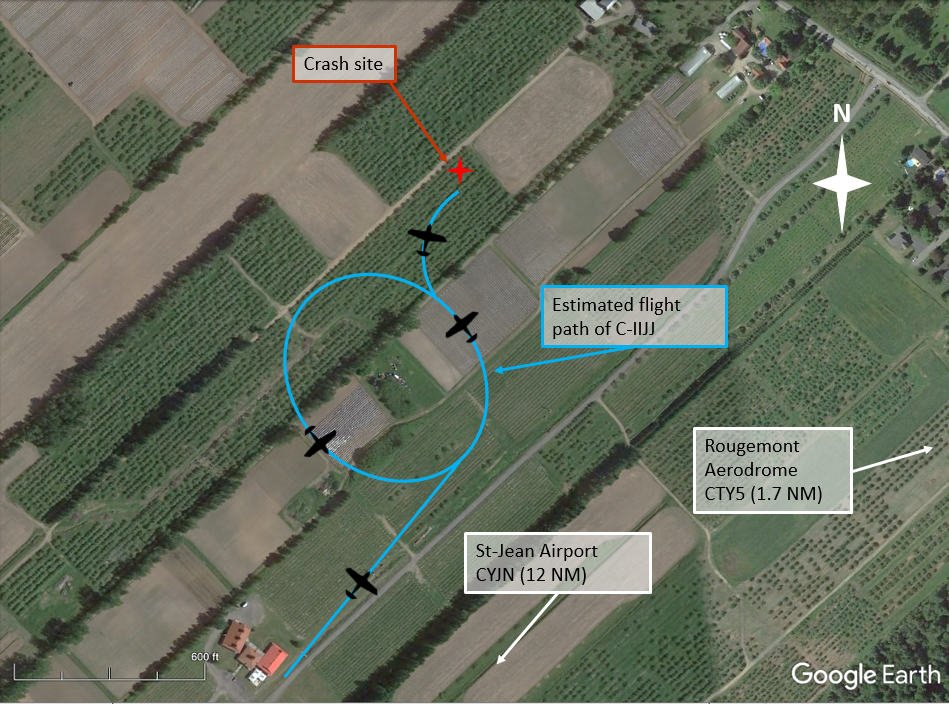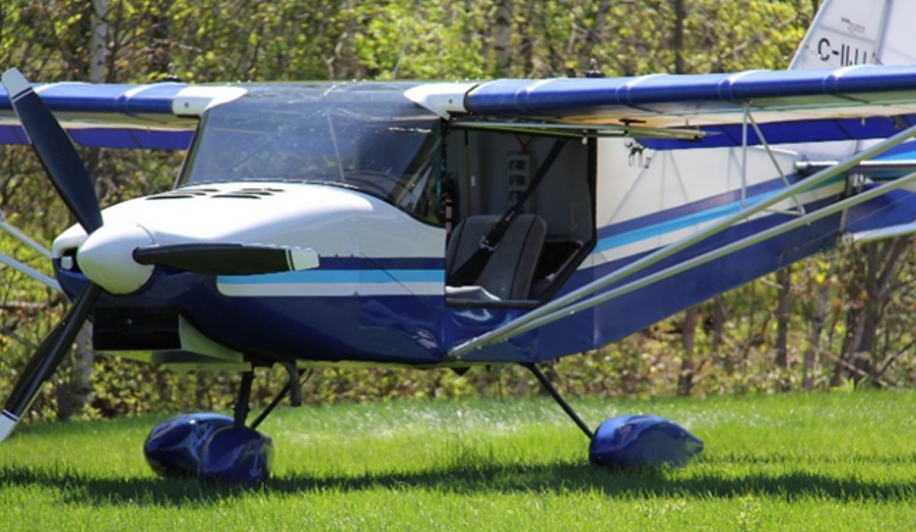Collision with trees
Rans S-6ES Coyote II ultralight aircraft
Rougemont, Quebec
The Transportation Safety Board of Canada (TSB) investigated this occurrence for the purpose of advancing transportation safety. It is not the function of the Board to assign fault or determine civil or criminal liability. This report is not created for use in the context of legal, disciplinary or other proceedings. See Ownership and use of content. Masculine pronouns and position titles may be used to signify all genders to comply with the Canadian Transportation Accident Investigation and Safety Board Act (S.C. 1989, c. 3).
Background
The advanced ultralight Rans S-6ES Coyote II (registration C‑IIJJ, serial number 06041577) was making a pleasure flight in the Rougement, Quebec, area with 2 people on board. The aircraft had been purchased on 09 January 2019, and its new owner planned to take the training required to obtain a pilot permit – ultralight aeroplane. The occurrence pilot, a friend of the owner, had flown the occurrence aircraft a few times since its acquisition. Moreover, some minor maintenance work had been performed on the aircraft following its acquisition.
History of the flight
On the morning of 01 July 2019, the pilot and the owner drove to the St-Hyacinthe Aerodrome (CSU3), Quebec, where the occurrence aircraft was located. At approximately 0950,Footnote 1 the pilot and sole occupant took off from CSU3 and conducted a visual flight rules (VFR) flight without incident to his private runway, which was approximately 5 nautical miles (NM) east of the St‑Jean Airport (CYJN), Quebec. Meanwhile, the owner drove to meet the pilot at his private runway, in order to make a pleasure flight.
At approximately 1125, the pilot took off for a local VFR pleasure flight in the vicinity of Rougemont, with the owner as passenger. At approximately 1133, the aircraft reportedly passed over an orchard in Rougemont at low altitude (i.e. less than 200 feet above ground level) in a counter-clockwise turn. At approximately 1135, the aircraft changed direction and turned northeast. It lost altitude and crashed into the orchard trees (Figure 1). The 2 occupants were fatally injured. No signal was detected from the emergency locator transmitter (ELT).
An individual who was in the vincinity of the accident site quickly contacted emergency services by dialling 911. The first responders arrived at 1149.
Weather information
According to the aerodrome routine meteorological report (METAR) issued at 1100 for the St-Hubert Airport (CYHU), Quebec, 15 NM northwest of the accident site, weather was favourable for this VFR flight and was not considered to have contributed to the accident.
Pilot information
The pilot had a valid pilot permit – ultralight aeroplane, issued 09 May 2016, and a valid Category 3 medical certificate. The pilot met Canadian Aviation Regulations (CARs) section 401.55 requirements regarding endorsements for the transportation of the passengers-carrying rating.
The pilot often conducted pleasure flights in the region. Since 2016, he had accumulated over 600 flight hours on ultralight aircrafts. In the months leading to the occurrence, he had flown the occurrence aircraft a few times. However, the investigation was unable to determine how many flight hours the pilot had accumulated on this aircraft type.
The investigation did not find that the pilot’s performance was degraded by fatigue or physiological factors.
Aircraft information
The Rans S-6ES Coyote II is a 2-seat, high-wing advanced ultralight aircraft made from metallic tubes covered in fabric. The aircraft was built in the United States in 2008. It was imported into Canada in early 2009 and inspected by a Rans representative, because it had never flown. The manufacturer then issued a certificate of compliance on 04 May 2009. When the aircraft was purchased on 09 January 2019, its technical logbook indicated that the aircraft had accumulated 336 flight hours since its construction.
According to the registration application submitted to Transport Canada, the aircraft had a maximum takeoff weight of 1100 pounds, an empty weight of 600 pounds and a stall speed of 42 mph.
The investigation was unable to determine the amount of fuel on board at takeoff. However, according to TSB calculations, the pilot had approximately 66 pounds available for fuel before reaching the maximum takeoff weight, which represents a little more than half of the tanks’ capacity (108 pounds).
The aircraft had a Rotax 912UL engine (serial number 4405286) manufactured by Bombardier Recreational Products (BRP). This engine is a liquid- and air-cooled 4-stroke 4-cyclinder engine, which generates 80 hp at a maximum engine speed of 5800 rpm.
An ultralight aircraft may be maintained by the owner, who must follow the maintenance program indicated by the manufacturer. The owner must also keep aircraft maintenance records.Footnote 2 According to the aircraft’s technical logbook, the last inspection was conducted on 01 September 2018, and the spark plugs were changed in January 2019, before the acquisition of the aircraft by the occurrence owner. According to the information gathered, minor maintenance of the carburetors was reportedly done by the new owner in the spring of 2019, but this work was not recorded in the logbook. Flights were reportedly conducted after January 2019, but they were also not recorded in the aircraft’s logbook.
The aircraft had no known deficiencies before the occurrence flight.
Accident site and examination of wreckage
The aircraft struck 2 rows of trees in the orchard and came to rest facing northwest in the 3rd row, when the wings hit the trees. The aircraft’s exact flight path could not be determined, because the aircraft was not equipped with a flight data recorder, and was not required to have one according to existing regulations.
The fuel tanks in the wings were damaged, causing a small fuel spill. When the TSB investigators arrived, the tanks still contained automobile-type fuel, which was appropriate for this engine type. The fuel in the feed lines, filters and carburetors was clear and uncontaminated. The 3 propeller blades were damaged: one was bent under the nose of the aircraft; another blade was broken and bent forward, while the 3rd was damaged but still in place and straight.
The Rotax 912UL engine sustained only minor damages: a cylinder head was damaged by impact with a tree trunk on the front left side. The engine was sent to the TSB Engineering Laboratory in Ottawa, Ontario, for analysis. The analysis did not reveal any internal faults with the engine pre- or post-accident. The damages to the propellers were not characteristic of a high-rpm impact. However, the investigation was unable to determine whether the engine was producing power at the time of the impact.
Damages to the wings and structure were caused by the impact and the actions of the first responders.
Global positioning system
The occurrence aircraft was equipped with a portable global positioning system (GPS). It was found intact and sent to the TSB Laboratory for data extraction. Given that the flight tracking feature was not selected, it was impossible to analyze any meaningful dataFootnote 3 for the occurrence flight.
Emergency locator transmitter
Although it was not required by regulations,Footnote 4 since it was an ultralight, the occurrence aircraft was equipped with a 121.5 MHz/243 MHz ELT. However, no maintenance activity was recorded in the technical logbook.
Apart from the coaxial cable to the antenna, which was not connected, the ELT was found intact. An examination found that it was no longer compliant with broadcasting standards and that the G-switches were defective. The batteries had not passed their expiry date, but they no longer held a charge.
Low altitude flight
The aircraft reportedly flew over an orchard and a field at a very low altitude (less than 200 feet above ground level), passing just above the trees. The CARs states that it is forbidden to fly “at a distance less than 500 feet from any person, vessel, vehicle or structure”.Footnote 5 This distance of 500 feet applies both in the horizontal and vertical planes. Therefore, flying at less than 200 feet above the ground is allowed, provided that a horizontal distance of more than 500 feet is maintained from any person, vessel or structure.
However, it is known that intentionally flying at a low altitude increases the risk of an accident. CARs and other publications specifically mention this risk. Furthermore, the TSB has recently investigated several occurrencesFootnote 6 for which this manoeuvre was identified as a contributing factor.
Pursuant to CARs, “No person shall operate an aircraft in such a reckless or negligent manner as to endanger or be likely to endanger the life or property of any person.”Footnote 7
The engine manufacturer provides the following warning in its user manual:
WARNING
Never fly the aircraft equipped with this engine at locations, air speeds, altitudes or in other situations which do not allow a successful no-power landing after sudden engine stoppage.Footnote 8
Under certain circumstances, a pilot may decide, for various reasons, to circle over a point of interest on the ground. If the pilot’s attention is fully drawn to observing the object on the ground, the pilot may neglect to control the speed, pitch and increase in load factor. Also, the pilot’s field of vision is reduced at low altitude. Consequently, the pilot has less time to take action to avoid obstacles and terrain. It is also recognized that flying at low altitude reduces the margin of safety in the event of engine failure, a loss of control or any other unexpected circumstances, while increasing the risk of an impact with the ground or an obstacle.
Safety messages
Flying an aircraft at low altitude leaves the pilot with little margin for error and increases the risk of not having enough time to manage an emergency. It is therefore important for pilots to comply with regulations and to heed any warning in the user manual regarding minimal altitude.
Although there were no repercussions on the end result of this occurrence, an ELT that is unable to transmit a signal exposes flight crews and passengers to the risk of delayed search and rescue operations. Therefore, when an ELT is installed in an aircraft, it is important to maintain and check the ELT to ensure that it works as intended.
This report concludes the Transportation Safety Board of Canada’s investigation into this occurrence. The Board authorized the release of this report on . It was officially released on .

